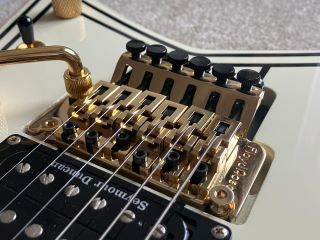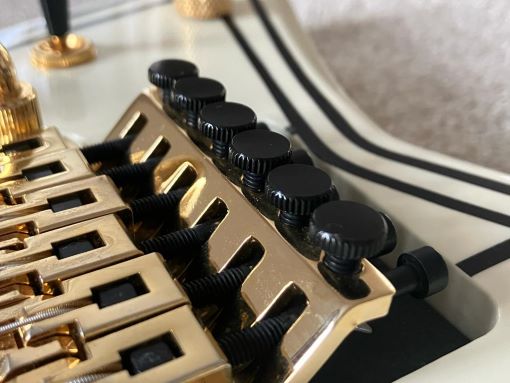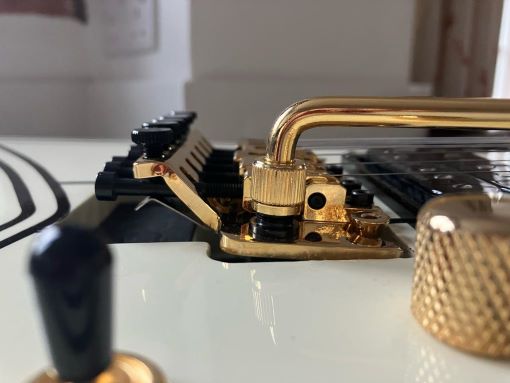TUNING A FLOYD ROSE TREMOLO
Tuning a guitar with a Floyd Rose tremolo can be a frustrating experience. Sometimes it feels like it’s actively fighting you and that you’ll never get the thing in tune! But there is a method to the madness and, once you understand it, tuning and balancing the tremolo become a relatively (I said ‘relatively’!) straightforward affair. Read on…
For present purposes, I’m going to ignore string height and intonation and assume you have a six-string electric guitar being tuned to standard pitch. That way we can just focus on tuning. Obviously, string height and intonation need to be set. Do this after tuning.

Here’s the process:
1. Perhaps the most crucial step—often forgotten—is to make sure the strings are well stretched. Otherwise, after you’ve tuned and set up the guitar they will stretch and lose pitch, and you will have to go through the tuning process all over again.
2. Loosen the string clamps at the nut. I remove them entirely until I’m ready to re-fit them. Small parts have a tendency to go missing! (A magnetic tray* is a great way to keep small metal parts like nuts and screws safe.)
3. On the bridge, set the fine-tuning adjusters to about 75% of the way ‘out’. Some sources (including Floyd Rose) say to put them in the middle of their adjustment range. However, more often than not you’ll use them to add tension to the strings rather than to remove it. Setting the adjusters further out gives you more scope to do this. Do not touch the fine-tuning adjusters again until step 10.
4. Using an electronic tuner, tune each string one at a time starting with the low E string and finishing with the high E string.

5. Now check the tuning of the low E string again. In all probability it will now be flat or sharp. This is where the fun begins!
6. Here’s what to do:
- Tune the low E string to pitch.
- Then tune the A, D, G & B strings slightly sharp (if the low E was flat) or slightly flat (if the low E was sharp). Tune the high E to pitch.
- Keep repeating these two steps until all the strings are in tune.

7. When all the strings are at the desired pitch, look at the alignment of the bridge compared to the guitar body. The bridge should be perfectly parallel to the surface of the guitar top. If it’s not, change the tension of the tremolo springs on the rear of the guitar by turning the screws on the spring claw. Screw the claw plate into the body if the bridge is tilted forward; loosen the screws if the bridge is tilted backwards.
8. Repeat steps 6 and 7 until the bridge is sitting parallel to the body when all strings are tuned to the desired pitch. This might involve a bit of back and forth.
9. Re-fit the string clamps at the nut.
10. Check the tuning of each string. If needed, make minor adjustments but only using the fine-tuning adjusters on the bridge.
After this, you will need to check the intonation of each string. If you have changed the orientation of the bridge (because it was tilted) you will have affected the intonation. If you make corrections to intonation, you might have to repeat steps 2-10.
You can apply this method to 7- or 8-string guitars, or to six-string guitars being set up in alternative tunings (e.g. drop D). Each step is exactly the same.
Now go out there and tame that tremolo!
* This is an affiliate link. If you purchase through this link we make a very small commission. You don’t pay any extra for the product.
NEED HELP SETTING UP A FLOYD ROSE TREMOLO?
Not everyone has the time or the inclination to manage the back and forth of setting up and tuning a ‘floating’ bridge.
We can help take the stress out of it.
Read about our competitively priced standard setup.
